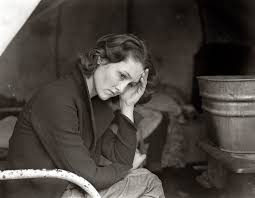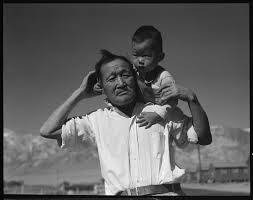Lange was educated in photography at Columbia University in New York City, in a class taught by Clarence H. White. She was informally apprenticed to several New York photography studios, including that of the famed Arnold Genthe. In 1918, she moved to San Francisco, and by the following year she had opened a successful portrait studio. She lived across the bay in Berkeley for the rest of her life. In 1920, she married the noted western painter Maynard Dixon, with whom she had two sons.
With the onset of the Great Depression, Lange turned her camera lens from the studio to the street. Her studies of unemployed and homeless people captured the attention of local photographers and led to her employment with the federal Resettlement Administration (RA), later called the Farm Security Administration (FSA).
In December 1935, she divorced Dixon and married economist Paul Schuster Taylor, Professor of Economics at the University of California, Berkeley.Taylor educated Lange in social and political matters, and together they documented rural poverty and the exploitation of sharecroppers, displaced farm families and migrant laborers for the next five years — Taylor interviewing and gathering economic data, Lange taking photos. From 1935-1939 her work for the RA and the FSA brought their plight to public attention – distributed free to newspapers across the country, her poignant images became icons of the era. Her best-known picture from this time is titled “Migrant Mother.” The woman in the photo is Florence Owens Thompson. The original photo featured Florence’s thumb and index finger on the tent pole, but the image was later retouched to hide Florence’s thumb. Her index finger was left untouched (lower right in photo – see images the gallery to compare them).
In 1960, Lange spoke about her experience taking the photograph:
- I saw and approached the hungry and desperate mother, as if drawn by a magnet. I do not remember how I explained my presence or my camera to her, but I do remember she asked me no questions. I made five exposures, working closer and closer from the same direction. I did not ask her name or her history. She told me her age, that she was thirty-two. She said that they had been living on frozen vegetables from the surrounding fields, and birds that the children killed. She had just sold the tires from her car to buy food. There she sat in that lean-to tent with her children huddled around her, and seemed to know that my pictures might help her, and so she helped me. There was a sort of equality about it.
In 1941, Lange was awarded a Guggenheim Fellowship for excellence in photography. After the attack on Pearl Harbor, she gave up the prestigious award to record the forced evacuation of Japanese Americans to relocation camps, on assignment for the War Relocation Authority (WRA). She covered the rounding up of Japanese Americans and their internment in relocation camps, highlighting Manzanar, the first of the permanent internment camps. To many observers, her photograph of Japanese-American children pledging allegiance to the flag shortly before they were sent to internment camps is a haunting reminder of this policy of detaining people without charging them with any crime or affording them any appeal. Her images were so obviously critical that the Army impounded them. Today her photographs of the internment are available in the National Archives on the website of the Still Photographs Division, and at the Bancroft Library of the University of California, Berkeley.
In 1945, Lange was invited by Ansel Adams to accept a position as faculty at the first fine art photography department at the California School of Fine Arts (CSFA) along with Imogen Cunningham and Minor White. In 1952, Lange co-founded the photographic magazine Aperture. Lange and Pirkle Jones were commissioned in the mid-1950s to shoot a photographic documentary for Life magazine of the death of Monticello, California and of the displacement of its residents by the damming of Putah Creek to form Lake Berryessa. The magazine did not run the piece, so Lange devoted one whole issue of Aperture to the work. The photo collection was shown at the Art Institute of Chicago in 1960.
In the last two decades of her life, Lange’s health was poor. She suffered from gastric problems, including bleeding ulcers, as well as post-polio syndrome — although this renewal of the pain and weakness of polio was not yet recognized by most physicians. Lange died of esophageal cancer on October 11, 1965, age 70. She was survived by her second husband, Paul Taylor, two children, three stepchildren, and numerous grandchildren and great-grandchildren.



































